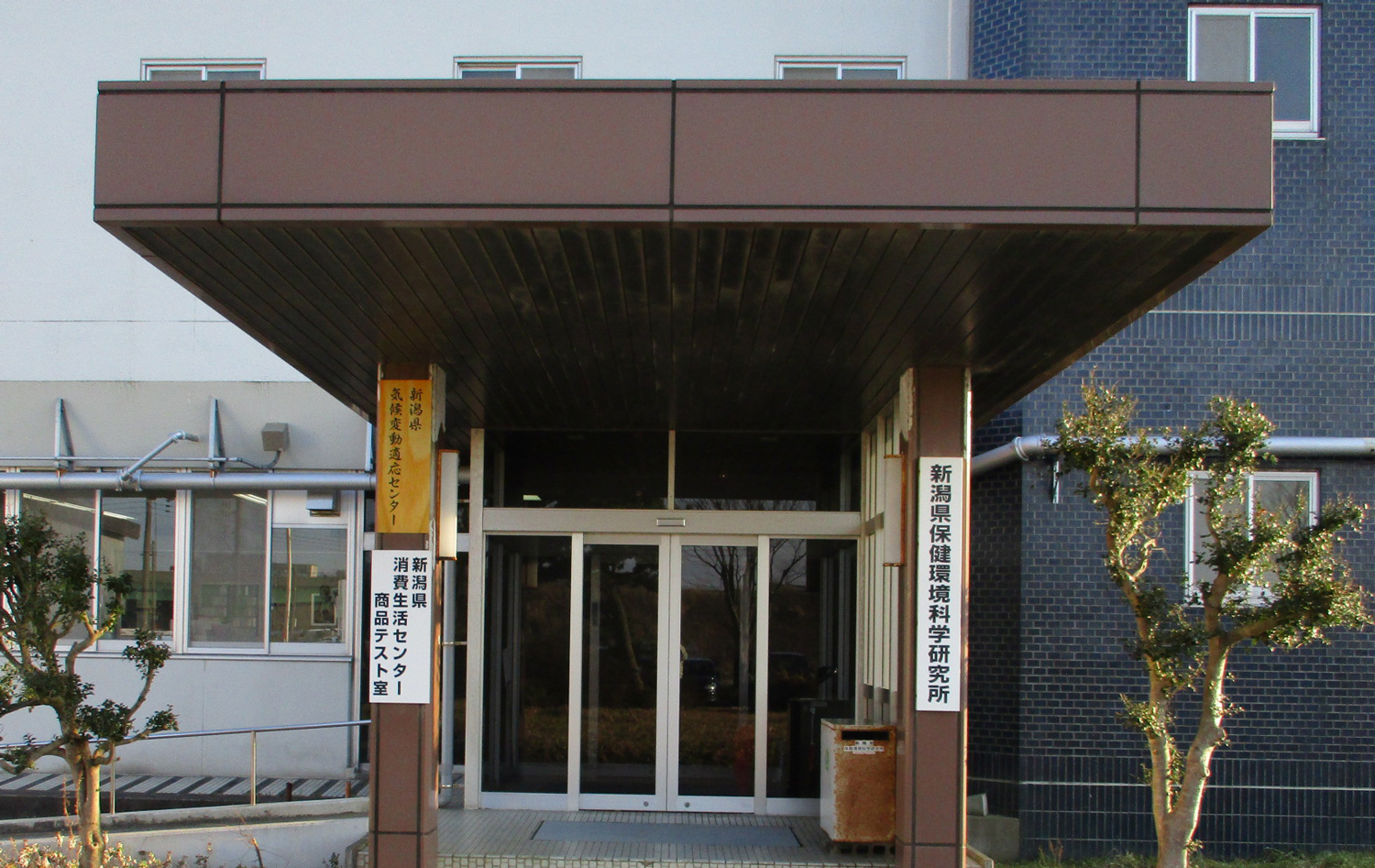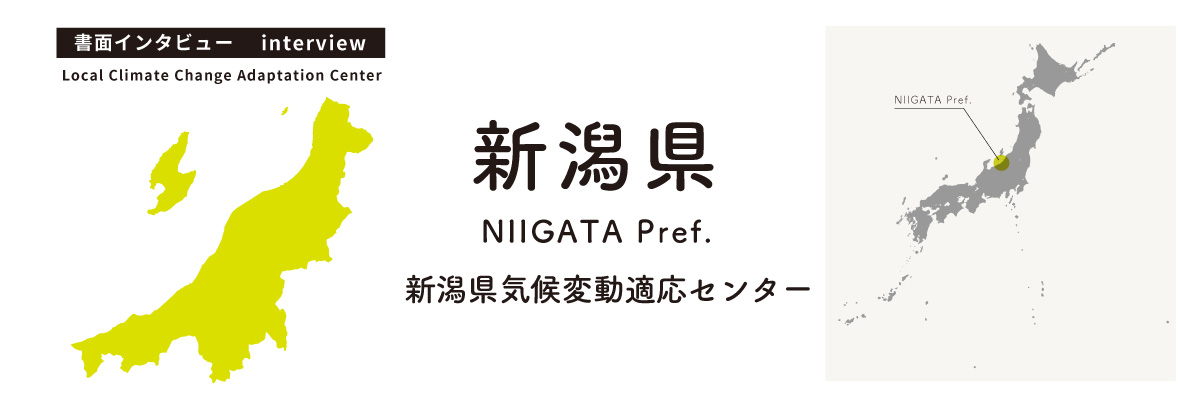Please tell us about Niigata Prefecture’s unique local features and characteristics, what led to the establishment of the Local Climate Change Adaptation Center, and what its organizational structure is like.
(1) Niigata Prefecture’s unique local features and characteristics
Niigata is one of the prefectures that has meteorological characteristics typical of the Honshu island climate bordering the Sea of Japan. The prefecture, the mountainous areas in particular, is known as one of the world’s heaviest snowfall regions. As such, Niigata Prefecture must constantly deal with the negative effects of heavy snow, including accidents that occur during snow removal, transport disruption, avalanches, and other disasters, while snowfalls also are proven to be precious tourism resources for the ski resorts and snow festivals that exist throughout the prefecture. Niigata also has this practice of snow utilization, which encourages the use of snow’s cooling energy for refrigeration, storage, and other purposes.
One distinct feature of the prefecture’s coastal climate bordering the Sea of Japan is the rise in temperature due to foehn winds. While several climate observation sites in Niigata Prefecture – registering upwards of 40°C – usually appear in the rankings of places with the highest temperatures in Japan as reported by the Japan Meteorological Agency, they are mainly caused by foehns.
In terms of topography, Niigata is surrounded by precipitous mountains, from which numerous rivers originate and flow into the Sea of Japan, along with more extensive watercourses such as the Shinano and Agano Rivers, creating vast and fertile agrarian areas along the way, including the Echigo and Takada Plains. Another unique feature is the geological structure known as Fossa Magna that runs across the prefecture, due to which Niigata has many areas that are prone to landslide. As such, Niigata frequently suffers disasters resulting from heavy rainfalls, so it is crucial for the prefecture to deal with them effectively.
Agriculture is a main industry of Niigata, and the prefecture is known as one of the largest producers of rice cultivars that are grown in paddy fields, the most notable of which is koshihikari. Niigata also produces large volumes of various fruits and flowering plants such as pears (e.g., Le Lectier) and tulips.
In terms of its commercial activities, Niigata Prefecture has strong ties to the Kanto region.
(2) What led to the establishment of the Climate Change Adaptation Center in Niigata Prefecture
The Niigata Prefectural Climate Change Adaptation Center was established in April 2019 at the Niigata Prefectural Institute of Public Health and Environmental Sciences as a center for gathering, organizing, analyzing, and disseminating information relating to climate change impact and adaptation in the region and for providing technical advice. The establishment of the Center at the Institute came about based on the premises (1) that as the national government intends for the National Institute for Environmental Studies (“NIES”) to play the central role in conducting surveys and research on the topic in coordination with local centers, the Niigata Prefectural Institute of Public Health and Environmental Sciences would be a suitable choice given its existing working relationship with the NIES and (2) that the Niigata Prefectural Institute of Public Health and Environmental Sciences – having already been assigned the task of calculating greenhouse gas emissions for the prefecture for years – would be able to utilize its know-how on related data accumulation and analysis.
(3) Organizational structure
The Local Climate Change Adaptation Center is assigned from the Niigata Prefectural Institute of Public Health and Environmental Sciences all operational tasks that are related to local climate change and has a staff of three that are employees of both organizations.

Please tell us about the current activities of Niigata’s Local Climate Change Adaptation Center as well as its future plans.
In 2019 and 2020, Niigata Prefecture organized a Niigata Prefectural Study Group on Climate Change Adaptation, comprised of experts from a wide range of disciplines, which would conduct surveys and research on the status of climate change in the prefecture based on cutting-edge science, predict future climatic conditions and impacts, and suggest climate change action policy and directions, etc. Based on the proposal submitted by the study group, Niigata formulated and officialized its prefectural climate change adaptation plan in March 2021. As the Local Climate Change Adaptation Center participated in the study group as a member of its secretariat, we have been updating our knowledge base using the insights obtained during the study group’s activities and been disseminating relevant information to the prefectural residents since.
While the prefectural plan lists paddy rice farming (for main dietary consumption), water disaster (flooding and inundation), snow-induced disaster, and extreme heat (hyperthermia, etc.) as the top four priorities of Niigata, these reflect the prefecture’s local features and characteristics in terms of climate, topography, industry, etc. So we intend to continuously communicate to prefectural residents our climate change prediction and adaptation suggestions in a fairly digestible form while taking into account the uniqueness of our locales.
Please tell us about any unique approach that your Local Climate Change Adaptation Center is taking to effectively coordinate with other departments of the Niigata Prefectural Government and to facilitate adaptation by the prefecture and businesses, as well as any issues, etc. you are experiencing.
The formulation and progress management of Niigata’s prefectural climate change adaptation plan are being handled by the Environmental Planning Division of the prefectural government. While interdepartmental coordination under the leadership of the Environmental Planning Division had already been going on prior to the formulation of the prefecture’s plan on the local facilitation of actions against global warming, we believe the Local Climate Change Adaptation Center must actively communicate to the public more specific examples of adaptation measures such as sample activities of the prefectural testing and research bodies and local organizations by leveraging the aforementioned interdepartmental cooperation.
When we conducted a questionnaire survey of prefectural residents in 2021, 62.9% of the respondents had never heard of the term “climate change adaptation” while 24.4% answered that they had heard the term but did not know what it meant. The same survey, however, indicated that large percentages of prefectural residents were keenly interested in measures addressing high heat, heavy rain and snowfalls, and other extreme weather conditions. As a whole range of extreme weather actions have been taken in agriculture, forestry, fishery, disaster prevention and control, and hot weather coping measures, we are planning on sharing sample practices and case studies with prefectural residents and business operators to explain to them what climate change adaptation actually is.
Please tell us what motivates you to do your current work and also your outlook on the future.
While Niigata Prefecture shares many meteorological characteristics with its neighboring areas such as the Hokuriku region, northern Nagano Prefecture, and the section of the Tohoku region facing the Sea of Japan, it has closer ties to the Kanto region both economically and socially. Therefore, even if one is pressed to assign Niigata to a single regional group, it can be part of Hokuriku, Shinetsu (Nagano and Niigata), Tohoku-plus-Niigata, and Kanto-Koshinetsu (Kanto plus Yamanashi, Nagano, and Niigata) at the same time, depending on the classification methodology. So we often think that Niigata’s uniqueness might actually lie in its very multifaceted connections to all these regions.
As for the Regional Council on Climate Change Adaptation, our Center is a member of the one in the Kanto region, while we find much relevant information in the activities of the Tohoku and Chubu Regional Councils that are adjacent to us. Indeed, our Center has been participating in the Snow resource (management) Subcommittee of the Tohoku Regional Council as an observer and been exchanging opinions and information with our counterparts across different Regional Councils.
While we have been gathering and analyzing a whole range of information on Niigata from internal as well as cross-regional sources to determine the impact of climate change on the prefecture and what actions should be taken to adapt, this research project has brought us to the realization that it’s all interconnected to the distinct uniqueness of our collective communities that make up Niigata, as well as the issues and challenges the prefecture faces, related to its terrain, weather, industrial composition, culture, etc. With such understanding, we are hoping to expand the scope of the Local Climate Change Adaptation Center’s activities by communicating and sharing concerns with a diverse group of people that have been studying and tackling climate change in their respective fields and obtaining their advice and insight.
(Posted on April 8, 2022)


